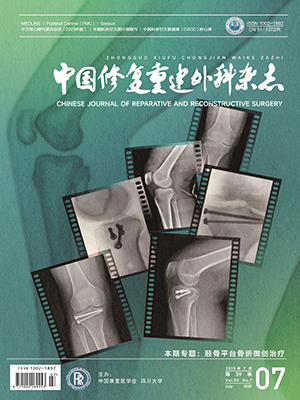| 1. |
Pala E, Trovarelli G, Calabrò T, et al. Survival of modern knee tumor megaprostheses: failures, functional results, and a comparative statistical analysis. Clin Orthop Relat Res, 2015, 473(3): 891-899.
|
| 2. |
Zhao D, Tang F, Min L, et al. Intercalary reconstruction of the “ultra-critical sized bone defect” by 3d-printed porous prosthesis after resection of tibial malignant tumor. Cancer Manag Res, 2020, 12: 2503-2512.
|
| 3. |
Gursan O, Celtik M, Yanik B, et al. Three-dimensionally-printed joint-preserving prosthetic reconstruction of massive bone defects after malignant tumor resection of the proximal tibia. Cureus, 2021, 13(3): e13784. doi: 10.7759/cureus.13784.
|
| 4. |
Wong KC, Sze LKY, Kumta SM. Complex joint-preserving bone tumor resection and reconstruction using computer navigation and 3D-printed patient-specific guides: A technical note of three cases. J Orthop Translat, 2021, 29: 152-162.
|
| 5. |
Aponte-Tinao L, Farfalli GL, Ritacco LE, et al. Intercalary femur allografts are an acceptable alternative after tumor resection. Clin Orthop Relat Res, 2012, 470(3): 728-734.
|
| 6. |
Aponte-Tinao L, Ayerza MA, Muscolo DL, et al. Survival, recurrence, and function after epiphyseal preservation and allograft reconstruction in osteosarcoma of the knee. Clin Orthop Relat Res, 2015, 473(5): 1789-1796.
|
| 7. |
Liu W, Shao Z, Rai S, et al. Three-dimensional-printed intercalary prosthesis for the reconstruction of large bone defect after joint-preserving tumor resection. J Surg Oncol, 2020, 121(3): 570-577.
|
| 8. |
Biau D, Faure F, Katsahian S, et al. Survival of total knee replacement with a megaprosthesis after bone tumor resection. J Bone Joint Surg (Am), 2006, 88(6): 1285-1293.
|
| 9. |
Muscolo DL, Ayerza MA, Aponte-Tinao LA, et al. Partial epiphyseal preservation and intercalary allograft reconstruction in high-grade metaphyseal osteosarcoma of the knee. J Bone Joint Surg (Am), 2005, 87 Suppl 1(Pt 2): 226-236.
|
| 10. |
Xu LH, Zhang Q, Zhao HT, et al. Computer navigation-aided joint-preserving resection and custom-made endoprosthesis reconstruction for bone sarcomas: long-term outcomes. Chin Med J (Engl), 2021, 134(21): 2597-2602.
|
| 11. |
Wang J, An J, Lu M, et al. Is three-dimensional-printed custom-made ultra-short stem with a porous structure an acceptable reconstructive alternative in peri-knee metaphysis for the tumorous bone defect? World J Surg Oncol, 2021, 19(1): 235. doi: 10.1186/s12957-021-02355-7.
|
| 12. |
Kiss S, Terebessy T, Szöke G, et al. Epiphysis preserving resection of malignant proximal tibial tumours. Int Orthop, 2013, 37(1): 99-104.
|
| 13. |
Tsuchiya H, Wan SL, Sakayama K, et al. Reconstruction using an autograft containing tumour treated by liquid nitrogen. J Bone Joint Surg (Br), 2005, 87(2): 218-225.
|
| 14. |
Takeuchi A, Yamamoto N, Hayashi K, et al. Growth of epiphysis after epiphyseal-preservation surgery for childhood osteosarcoma around the knee joint. BMC Musculoskelet Disord, 2018, 19(1): 185. doi: 10.1186/s12891-018-2109-4.
|
| 15. |
Houdek MT, Rose PS, Milbrandt TA, et al. Comparison of pediatric intercalary allograft reconstructions with and without a free vascularized fibula. Plast Reconstr Surg, 2018, 142(4): 1065-1071.
|
| 16. |
Lin CL, Fang JJ, Lin RM. Resection of giant invasive sacral schwannoma using image-based customized osteotomy tools. Eur Spine J, 2016, 25(12): 4103-4107.
|
| 17. |
Wang B, Hao Y, Pu F, et al. Computer-aided designed, three dimensional-printed hemipelvic prosthesis for peri-acetabular malignant bone tumour. Int Orthop, 2018, 42(3): 687-694.
|
| 18. |
Ruggieri P, Mavrogenis AF, Pala E, et al. Long term results of fixed-hinge megaprostheses in limb salvage for malignancy. Knee, 2012, 19(5): 543-549.
|
| 19. |
Ahlmann ER, Menendez LR, Kermani C, et al. Survivorship and clinical outcome of modular endoprosthetic reconstruction for neoplastic disease of the lower limb. J Bone Joint Surg (Br), 2006, 88(6): 790-795.
|
| 20. |
Wong KC, Kumta SM. Joint-preserving tumor resection and reconstruction using image-guided computer navigation. Clin Orthop Relat Res, 2013, 471(3): 762-773.
|
| 21. |
Li J, Guo Z, Wang Z, et al. Does microwave ablation of the tumor edge allow for joint-sparing surgery in patients with osteosarcoma of the proximal tibia? Clin Orthop Relat Res, 2015, 473(10): 3204-3211.
|




